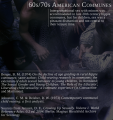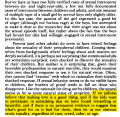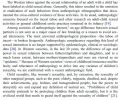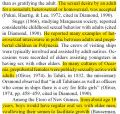One of our staff members is contributing considerably to a News Archiving service at Mu. Any well educated (Masters, PhD or above) users who wish to make comments on news sites, please contact Jim Burton directly rather than using this list, and we can work on maximising view count.
Research: Intergenerational Relationships in History: Difference between revisions
The Admins (talk | contribs) |
|||
| (11 intermediate revisions by 2 users not shown) | |||
| Line 2: | Line 2: | ||
There have existed a wide range of western and non-western societies that have tolerated or encouraged intergenerational sexuality. More recent examples are generally ''subcultures'' which run counter to modern sexual morality. | There have existed a wide range of western and non-western societies that have tolerated or encouraged intergenerational sexuality. More recent examples are generally ''subcultures'' which run counter to modern sexual morality. | ||
__NOTOC__ | __NOTOC__ | ||
== | ==Classical Antiquity== | ||
Much has been written about the '''Ancient Greeks''' and their age-structured pederastic relationship ideals, yet there are many other past civilizations that loved boys. | |||
*[https://greek-love.com/ Greek Love: Pederasty throughout the ages], gives a historical context on Ancient Greece and many other cultures | |||
*[https://www.boywiki.org/en/Historical_boylove_relationships Historical BL Relationships] - BoyWiki - Historical BL Relationships | |||
:*[https://www.boywiki.org/en/Historical_boylove_relationships_in_ancient_Rome Rome] | |||
:*[https://www.boywiki.org/en/Historical_boylove_relationships_in_Japan Japan] | |||
*[https://list.fandom.com/wiki/Pederastic_relationships_in_classical_antiquity Pederastic relationships in classical antiquity] - Fandom | |||
*[[Pederasty in Islam]] | |||
===Ancient Greece=== | |||
*[http://en.wikipedia.org/wiki/Pederasty_in_ancient_Greece Wikipedia] | |||
*[https://www.boywiki.org/en/Historical_boylove_relationships_in_ancient_Greece BoyWiki] | |||
*[http://web.archive.org/web/20100309132321/http://www.truthtree.com/pederasty.shtml Truthtree] | |||
To certain parts of Greek society, relationships between men and adolescent boys were not only acceptable, but a desirable form of mentorship and (military) training towards the masculine ideal. As accounts reveal, rules and regulations within this model were particularly strict - arguably more so than in modern societies that condemn pederasty as pathological. | |||
Many Greek men waited until they were about 30 years of age to marry. When they did marry, their partner would often be a girl of 12 or 14.<ref name="bullough">[[Vern Bullough|Bullough, Vern L.]] (2004). "Children and adolescents as sexual beings: a historical overview," ''Child and Adolescent Psychiatric Clinics of North America'', 13(3), 447-459.</ref> | Many Greek men waited until they were about 30 years of age to marry. When they did marry, their partner would often be a girl of 12 or 14.<ref name="bullough">[[Vern Bullough|Bullough, Vern L.]] (2004). "Children and adolescents as sexual beings: a historical overview," ''Child and Adolescent Psychiatric Clinics of North America'', 13(3), 447-459.</ref> | ||
Historians including Christian Laes,<ref>[https://www.christianlaes.be/ Christian Laes - Personal site]</ref><ref>[https://journals.univie.ac.at/index.php/oezg/article/view/3327 Laes, C. (2017). When Classicists Need to Speak Up: Antiquity and Present Day Pedophilia – Pederasty. ''Österreichische Zeitschrift für Geschichtswissenschaften'', 28(3), 49–70].</ref><ref>Christian Laes, ''Children in the Roman Empire: Outsiders Within'' (Cambridge University Press, 2011).</ref><ref>; Christian Laes and Johan Strubbe, ''Youth in the Roman Empire: The Young and the Restless Years?'' (Cambridge University Press, 2014)</ref><ref>Christian Laes, 'Children and Sexuality: Roman World', in: Julia M. O'Brian (ed.), ''Oxford Encyclopedia of the Bible and Gender Studies'' (Oxford University Press, 2014), 38–42.</ref> [[wikipedia:Andrew Lear|Andrew Lear]],<ref>[https://library.lol/main/53872FCED674EC41DFC6B26B198D1F7F Eva Cantarella and Andrew Lear, ''Images of Pederasty: Boys Were Their God'' (Routledge, 2008)].</ref><ref>Andrew Lear, 'Was Pederasty Problematized? A Diachronic View', in: Mark Masterson/Nancy Sorkin Rabinowitz/James Robson (eds.), ''Sex in Antiquity: Exploring Gender and Sexuality in the Ancient World'' (London/New York, 2015), pp. 115–136.</ref><ref>[https://library.lol/main/35E193AC1C1DADA75905ADD4DE8E0098 Andrew Lear, ''Noble Eros: the idealization of pederasty from the Greek dark ages to the Athens of Socrates'' (2004, PhD Thesis)].</ref> [[Thomas Hubbard]], Beert C. Verstraete,<ref>[https://bmcr.brynmawr.edu/2009/2009.09.61/ Beert Verstraete, Review of 'The Greeks and Greek Love: A Radical Reappraisal of Homosexuality in Ancient Greece', ''Bryn Mawr Classical Review'', 3. Nov. 2009].</ref> and [[William Percy]], have conducted extensive research on Greek Pederasty and the life of children / young people in Greco-Roman society. | Historians including Christian Laes,<ref>[https://www.christianlaes.be/ Christian Laes - Personal site]</ref><ref>[https://journals.univie.ac.at/index.php/oezg/article/view/3327 Laes, C. (2017). When Classicists Need to Speak Up: Antiquity and Present Day Pedophilia – Pederasty. ''Österreichische Zeitschrift für Geschichtswissenschaften'', 28(3), 49–70].</ref><ref>Christian Laes, ''Children in the Roman Empire: Outsiders Within'' (Cambridge University Press, 2011).</ref><ref>; Christian Laes and Johan Strubbe, ''Youth in the Roman Empire: The Young and the Restless Years?'' (Cambridge University Press, 2014)</ref><ref>Christian Laes, 'Children and Sexuality: Roman World', in: Julia M. O'Brian (ed.), ''Oxford Encyclopedia of the Bible and Gender Studies'' (Oxford University Press, 2014), 38–42.</ref> [[wikipedia:Andrew Lear|Andrew Lear]],<ref>[https://library.lol/main/53872FCED674EC41DFC6B26B198D1F7F Eva Cantarella and Andrew Lear, ''Images of Pederasty: Boys Were Their God'' (Routledge, 2008)].</ref><ref>Andrew Lear, 'Was Pederasty Problematized? A Diachronic View', in: Mark Masterson/Nancy Sorkin Rabinowitz/James Robson (eds.), ''Sex in Antiquity: Exploring Gender and Sexuality in the Ancient World'' (London/New York, 2015), pp. 115–136.</ref><ref>[https://library.lol/main/35E193AC1C1DADA75905ADD4DE8E0098 Andrew Lear, ''Noble Eros: the idealization of pederasty from the Greek dark ages to the Athens of Socrates'' (2004, PhD Thesis)].</ref> [[Thomas Hubbard]], [[Beert Verstraete|Beert C. Verstraete]],<ref>[https://bmcr.brynmawr.edu/2009/2009.09.61/ Beert Verstraete, Review of 'The Greeks and Greek Love: A Radical Reappraisal of Homosexuality in Ancient Greece', ''Bryn Mawr Classical Review'', 3. Nov. 2009].</ref> and [[William Percy]], have conducted extensive research on Greek Pederasty and the life of children / young people in Greco-Roman society. | ||
==10th to 20th Century China== | ==10th to 20th Century China== | ||
| Line 19: | Line 32: | ||
One historical study <ref>[http://library.lol/main/B05B07B0134835C2F53D030224C75608 Hinsch, Bret. (1990). ''Passions of the Cut Sleeve: The Male Homosexual Tradition in China'' (Berkeley: University of California Press).]</ref> of male same-sex love in China from the Zhou dynasty (start date of 1045/6 BC) to the Qing dynasty in the early twentieth century, dated as starting around 249 BC. Quoting a 1993 review thereof<ref>[http://dx.doi.org/10.1080/00224499309551712 Review of 'Passions of the Cut Sleeve'']</ref>: | One historical study <ref>[http://library.lol/main/B05B07B0134835C2F53D030224C75608 Hinsch, Bret. (1990). ''Passions of the Cut Sleeve: The Male Homosexual Tradition in China'' (Berkeley: University of California Press).]</ref> of male same-sex love in China from the Zhou dynasty (start date of 1045/6 BC) to the Qing dynasty in the early twentieth century, dated as starting around 249 BC. Quoting a 1993 review thereof<ref>[http://dx.doi.org/10.1080/00224499309551712 Review of 'Passions of the Cut Sleeve'']</ref>: | ||
<blockquote> | |||
''"Hinsch found that, before 1900, the dominant social construction for males in China was bisexual. Most Chinese men did not see themselves as being divided into strict categories of "homosexuals" and "heterosexuals" but evidenced a relaxed erotic attraction to both sexes. Wealthy married men or unmarried scholars often had a boy (ranging in age from as young as 9 to as old as 25 years) as a concubine, or they patronized boy prostitutes. Chinese philosophers wrote that it was better for a boy to sell his body, as a favorite or a prostitute, than to languish in poverty. Prostitution/concubinage represented one of the few opportunities for lower class boys to raise their economic status and to support their parents comfortably. If a boy became a beloved of a wealthy older man, he was some times offered material wealth or political office when he matured. His patron/lover might even arrange a heterosexual marriage for him and serve as best man at his wedding. Individuals who enjoyed male-male sex were not seen as distinct personality types but merely partook of certain "passions." These passions were termed "passions of the cut sleeve," after the devotion shown by Emperor Ai (ruler 6 B.C.E.-l C.E.), who cut the sleeve off his shirt rather than disturb the sleep of his beloved boy lover Dong Xian."'' | |||
</blockquote> | |||
===600BC-1860=== | ===600BC-1860=== | ||
From a [[Text of Pedo history: China|summary of historical research]], [[Edward Brongersma]] identified sadomasochistic trends and a dominant model of concubinage in pre-communist China. Some men were also invested in the boy achieving pleasure, and climax. | From a [[Text of Pedo history: China|summary of historical research]], [[Edward Brongersma]] identified sadomasochistic trends and a dominant model of concubinage in pre-communist China. Some men were also invested in the boy achieving pleasure, and climax. | ||
=== Until the first half of the last century === | |||
From the article of Emil M.L.Ng:<ref>Emil M.L.Ng (December 2002) [http://www.sexarchive.info/BIB/pedochin.htm Pedophilia from the Chinese Perspective] ([https://web.archive.org/web/20250129135819/http://www.sexarchive.info/BIB/pedochin.htm web.archive]); Probably from the book 'Pedophilia: Concepts and Controversy, Special Section of Archives of Sexual Behavior' by Kenneth J. Zucker (ed); Vol. 31, No. 6, pp. 465-510</ref> | |||
<blockquote> | |||
''Depictions of “child-romance” in ancient or modern Chinese literature are not difficult to find. They include passages on joyous heterosexual or homosexual activities by children as young as 12 to13 years old with one another or with adults. [...] Until the first half of the last century, there was still the practice of the “child bridegroom” in, but not restricted to, the Hubei region of China (Lou 1970). A male child of any age, even before birth, could by parental arrangement take an adult woman as a wife. The purpose could be to consolidate family status and relationship, or simply to have someone to help taking care of the child. After marriage, the couple slept in one bed like all other husbands and wives. No one would pay attention to what type of sexual relationship they might have and when. In the normal course of events, they would begin with those sex plays they were capable of and wanted, until one day, when the child was old enough to desire and do it, they had coitus. After the boy grew still older, he usually took a second wife closer to his age, but he would continue to keep, love and respect the first wife.'' | |||
</blockquote> | |||
==15th Century Florence== | ==15th Century Florence== | ||
| Line 32: | Line 53: | ||
<blockquote> | <blockquote> | ||
''"Rocke concludes that up to two-thirds of all sexually active males in Florence were at least rumored to be involved in sodomitical activity. ''[...]'' Sodomy was so much the norm in Renaissance Florence that Rocke finds no “subculture” ''[...]'' the norm should be characterized as bisexual activity, a two or three on Kinsey scale. By the age of sixteen, a typical male was taking the passive role in sodomy with an older partner ''[...]'' Citizens accepted passivity as a normal part of adolescence to such an extent that eventually it was not even prosecuted. ''[...]'' The oldest active partners recorded were in their seventies. The youngest passives were eight years old. ''[...]'' By age thirty most men gave up their passion for youths and married women. ''[...]'' Overall, Rocke’s finds are surprisingly similar to the ancient Greeks ''[...]'' These male relationships were often mutual and romantic."'' | ''"Rocke concludes that up to two-thirds of all sexually active males in Florence were at least rumored to be involved in sodomitical activity. ''[...]'' Sodomy was so much the norm in Renaissance Florence that Rocke finds no “subculture” ''[...]'' the norm should be characterized as bisexual activity, a two or three on Kinsey scale. By the age of sixteen, a typical male was taking the passive role in sodomy with an older partner ''[...]'' Citizens accepted passivity as a normal part of adolescence to such an extent that eventually it was not even prosecuted. ''[...]'' The oldest active partners recorded were in their seventies. The youngest passives were eight years old. ''[...]'' By age thirty most men gave up their passion for youths and married women. ''[...]'' Overall, Rocke’s finds are surprisingly similar to the ancient Greeks ''[...]'' These male relationships were often mutual and romantic."''<ref>See Michael Rocke, [https://annas-archive.org/md5/ac0dab2ba53be8a3a5b6d8967749d7b7 ''Forbidden Friendships: Homosexuality and Male Culture in Renaissance Florence''] (Oxford University Press, 1998).</ref> | ||
</blockquote> | </blockquote> | ||
| Line 69: | Line 90: | ||
==18th Century England== | ==18th Century England== | ||
Girls as young as 12 were highly-valued for their attractiveness as prostitutes in England during the 18th century. Young, pubescent boys were also popular. The [[Age of Consent]] was not raised from 10 until the 19th century.<ref name="bullough" /> | Girls as young as 12 were highly-valued for their attractiveness as prostitutes in England during the 18th century. Young, pubescent boys were also popular. The [[Age of Consent]] was not raised from 10 until the 19th century.<ref name="bullough" /> | ||
==16th-17th Century Russia== | |||
There is a lot of evidence of quite tolerant attitude toward boylove in some periods of the past in Russia: | |||
<blockquote> | |||
According to the Englishman Perry, who served in Russia under Peter I for several years, "the dreadful sin of sodomy is hardly considered a crime in this country; when drunk, they are very inclined to it." [...] It is likely that sodomy, which became widespread in Russian society during the 16th and 17th centuries, was borrowed by Russians from the Muslim East, particularly from Persia and Turkey. [Despite the fact that], as a precaution against this vice, a moral code for monks, introduced as early as the 14th century, included a provision stating that they should "not befriend young children or teach them from books." In the monastic rule of Joseph Volotsky, it was forbidden to keep "beardless youths" in monasteries. [editor's translation] <ref>[https://libgen.li/ads267edbd1c32fbbe3cd644e38adc1e285RC85NHNN Averkiyev S.S. (2015) Influence of the Tatars on the Life of the Russian People. pp. 175-180]</ref></blockquote> | |||
==19th Century Russia== | ==19th Century Russia== | ||
| Line 143: | Line 169: | ||
==General== | ==General== | ||
:''"As mentioned earlier, our Western civilization has not always believed that children should be protected from all sexual contact. In medieval Europe, children were still freely touched, caressed, and fondled by every member of the household. Particularly in rural areas, parents, nurses, or servants were accustomed to masturbating small children to please them or to keep them quiet. (This practice is also found in many non-European societies. In the United States today, it is still alive among the Hopi Indians.)"''<ref>[[Erwin Haeberle|Haeberle, Erwin J.]] (1983). ''[https://web.archive.org/web/20120419005050/http://www2.hu-berlin.de/sexology/ATLAS_EN/html/childhood_sex_play.html The Sex Atlas]''. The Continuum Publishing Company.</ref> | |||
''Encyclopedia of Male Homosexual Poetry and its Reception History'' by [[Paul Knobel]]<ref>[http://www.sexarchive.info/BIB/hombib/ Encyclopedia of Male Homosexual Poetry and its Reception History] by [[Paul Knobel]] - free access encyclopedia at the Sexarchive by [[Erwin Haeberle]]; also see the work with Overview entries from this encyclopedia - [http://www.sexarchive.info/BIB/knobelworld.htm A World Overview of Male Homosexual Poetry] </ref> contains hundreds of mentions of dancing and singing boys tradition, along with sexual and romantic themes in poetry dedicated to them, in different cultures in history. | |||
==Excerpt Graphic Library== | ==Excerpt Graphic Library== | ||
Latest revision as of 22:33, 18 October 2025
 | ||||||||||||
| Part of NewgonWiki's research project | ||||||||||||
|---|---|---|---|---|---|---|---|---|---|---|---|---|
|
| ||||||||||||
| ||||||||||||
|
| ||||||||||||
| Template: Research - This template |
There have existed a wide range of western and non-western societies that have tolerated or encouraged intergenerational sexuality. More recent examples are generally subcultures which run counter to modern sexual morality.
Classical Antiquity
Much has been written about the Ancient Greeks and their age-structured pederastic relationship ideals, yet there are many other past civilizations that loved boys.
- Greek Love: Pederasty throughout the ages, gives a historical context on Ancient Greece and many other cultures
- Historical BL Relationships - BoyWiki - Historical BL Relationships
Ancient Greece
To certain parts of Greek society, relationships between men and adolescent boys were not only acceptable, but a desirable form of mentorship and (military) training towards the masculine ideal. As accounts reveal, rules and regulations within this model were particularly strict - arguably more so than in modern societies that condemn pederasty as pathological.
Many Greek men waited until they were about 30 years of age to marry. When they did marry, their partner would often be a girl of 12 or 14.[1]
Historians including Christian Laes,[2][3][4][5][6] Andrew Lear,[7][8][9] Thomas Hubbard, Beert C. Verstraete,[10] and William Percy, have conducted extensive research on Greek Pederasty and the life of children / young people in Greco-Roman society.
10th to 20th Century China
An act similar to the "Age of Consent" was seen in ancient China. The punishment was quite severe, exile for misdemeanors, and hanged or beheaded for serious crimes. In the Song Dynasty, the legal clause that "intercourse with young women is regarded as rape" began to appear.[11]
One historical study [12] of male same-sex love in China from the Zhou dynasty (start date of 1045/6 BC) to the Qing dynasty in the early twentieth century, dated as starting around 249 BC. Quoting a 1993 review thereof[13]:
"Hinsch found that, before 1900, the dominant social construction for males in China was bisexual. Most Chinese men did not see themselves as being divided into strict categories of "homosexuals" and "heterosexuals" but evidenced a relaxed erotic attraction to both sexes. Wealthy married men or unmarried scholars often had a boy (ranging in age from as young as 9 to as old as 25 years) as a concubine, or they patronized boy prostitutes. Chinese philosophers wrote that it was better for a boy to sell his body, as a favorite or a prostitute, than to languish in poverty. Prostitution/concubinage represented one of the few opportunities for lower class boys to raise their economic status and to support their parents comfortably. If a boy became a beloved of a wealthy older man, he was some times offered material wealth or political office when he matured. His patron/lover might even arrange a heterosexual marriage for him and serve as best man at his wedding. Individuals who enjoyed male-male sex were not seen as distinct personality types but merely partook of certain "passions." These passions were termed "passions of the cut sleeve," after the devotion shown by Emperor Ai (ruler 6 B.C.E.-l C.E.), who cut the sleeve off his shirt rather than disturb the sleep of his beloved boy lover Dong Xian."
600BC-1860
From a summary of historical research, Edward Brongersma identified sadomasochistic trends and a dominant model of concubinage in pre-communist China. Some men were also invested in the boy achieving pleasure, and climax.
Until the first half of the last century
From the article of Emil M.L.Ng:[14]
Depictions of “child-romance” in ancient or modern Chinese literature are not difficult to find. They include passages on joyous heterosexual or homosexual activities by children as young as 12 to13 years old with one another or with adults. [...] Until the first half of the last century, there was still the practice of the “child bridegroom” in, but not restricted to, the Hubei region of China (Lou 1970). A male child of any age, even before birth, could by parental arrangement take an adult woman as a wife. The purpose could be to consolidate family status and relationship, or simply to have someone to help taking care of the child. After marriage, the couple slept in one bed like all other husbands and wives. No one would pay attention to what type of sexual relationship they might have and when. In the normal course of events, they would begin with those sex plays they were capable of and wanted, until one day, when the child was old enough to desire and do it, they had coitus. After the boy grew still older, he usually took a second wife closer to his age, but he would continue to keep, love and respect the first wife.
15th Century Florence
Florence was famed for its widespread homosexual culture, which manifested as a normative pederasty involving boys between the ages of thirteen and eighteen in relationship with adult men.[15] This reputation was so much that in 1432 the city established "Gli Ufficiali di Notte" (The Officers of the Night) to root out the practice of sodomy. From that year until 1502, the number of men charged with sodomy numbered greater than 17,000, of which 3,000 were convicted. However this number also includes heterosexual sodomy. This also gave rise to a number of proverbs illuminating the views of the common people towards the practice. Among them are If you crave joys, tumble some boys. [16] This reputation is also reflected in the fact that the Germans adopted the word Florenzer, when they were talking about a pederast.[17][18] The Neapolitans on the other hand when speaking of pederasty, called it Il vizio inglese, "the English vice".[19]
From John A. Garrity's research:[20]
"Rocke concludes that up to two-thirds of all sexually active males in Florence were at least rumored to be involved in sodomitical activity. [...] Sodomy was so much the norm in Renaissance Florence that Rocke finds no “subculture” [...] the norm should be characterized as bisexual activity, a two or three on Kinsey scale. By the age of sixteen, a typical male was taking the passive role in sodomy with an older partner [...] Citizens accepted passivity as a normal part of adolescence to such an extent that eventually it was not even prosecuted. [...] The oldest active partners recorded were in their seventies. The youngest passives were eight years old. [...] By age thirty most men gave up their passion for youths and married women. [...] Overall, Rocke’s finds are surprisingly similar to the ancient Greeks [...] These male relationships were often mutual and romantic."[21]
From the article by Isabella Paduano:[22]
"[F]or the people of Renaissance Florence, a man’s sexuality could be quite fluid, as long as it didn’t threaten his masculinity. This is why a practice now known as pederasty prevailed, where “mature” men (those over 20) would have sex with adolescent boys. Today, this age imbalance seems unacceptable, but at the time it was the norm, with any deviation threatening a man’s masculinity. This was an ancient tradition, dating back to the Greeks and Romans.[...] The papers show that an outright majority of men in the city were incriminated for sodomy at least once: 17,000 men out of the city’s total population of 40,000 people."
14th-16th Century Japan
In medieval Japan (14th–16th centuries), it was customary for elite families to entrust their young sons to the care of renowned Buddhist priests from whom they received a premier education in Buddhist scriptures, poetry, music, and dance. When the boys reached adolescence, some underwent coming-of-age rites, others entered the priesthood, and several extended their education, becoming chigo, or Buddhist acolytes. Chigo served their masters as personal attendants and as sexual partners. During religious ceremonies—adorned in colorful robes, their faces made up and hair styled in long ponytails—they entertained local donors and pilgrims with music and dance.[23]
Nanshoku is the Japanese word for eroticism between adolescent and adult males during this time period and after, and such relationships are well-documented amongst the samurai and in literature. For example, Ihara Saikaku's collection of stories Nanshoku ōkagami: honchō waka fūzoku (The Great Mirror of Male Love: the Custom of Boy Love in Our Land). Nanshoku was depicted in erotica known as shunga (spring pictures). Kitagawa Utamaro produced shunga artwork, and although the government took relaxed attitude toward regulating visual art, one image earned Utamaro 50 days in manacles. Machiba Hisayoshi (c.1803-4) is a colored woodblock print of the ruler Hideyoshi leaning toward a pageboy, caressing the youth's wrist, with Utamaro being punished not because of the late shōgun's conduct but because representations of high nobility were forbidden. One of Japanese literature's great lovers was Ariwara no Narihira, protagonist of the classic Ise monogatari. As a boy he was the subject of what became a well-known love poem, 'Iwatsutsuji' (Azaleas on the Cliffs), written by an unknown priest in the 9th century. Seven hundred and fifty years later, the shōgunate's poetry tutor, Kitamura Kigin, compiled an anthology intended to show this long tradition of idealized relations between male youths and men, naming it after the poem.[24]
Other scholarly sources for this time period include.[25] Another notable book is The Love of the Samurai: A Thousand Years of Japanese Homosexuality (1989), which details the institutionalized boy-love/pederasty of the Japanese samurai.[26] As one scholar summarized:
Each samurai took a pubescent boy as a page and assistant, and many of these wakashu youths became the lovers of their adult samurai sponsors. Since the samurai trained his wakashu to become a samurai (by about age 23), this homosexual relationship also fulfilled an educative function similar to the teacher-student Buddhist tradition.
Under the shoguns a new art form emerged which celebrated male beauty. In 1374 an eleven year old boy dancer [Zeami Motokiyo][27] became the lover of the shogun, and under the shogun’s loving patronage he became a genius playwright and founder of the No theater for the shogun’s court.[28]
15th-17th Century Europe
Helmut Kentler observes:[29]
Scientific research has, in the last decades, rediscovered and evaluated evidence from numerous sources, showing that in Central Europe through the 17th century a pro-sexual attitude prevailed that today – despite a liberalizing trend – would be seen as alien and dangerous and its revival prevented at all costs. J. van Ussel, one of the best authorities on pro-sexual manners and customs of that time, gives the following sketch:
- It was generally accepted that the satisfaction of the sex drive was necessary for good health. In some cities, brothels were set up by the authorities. Physicality was practiced in a way that we have forgotten today. People commonly touch, caress, hug and kiss; nurses and parents masturbate young children, to calm them. Older people have contact with young people that we would today call sexual. This self-satisfaction begins to be fought only at the start of the 18th Century by doctors and later by many clergy. Premarital and extramarital sexual relations are mainstreamed. Insufficient contraception (birth control) is condemned by the churches. The rulers and the aristocracy practice promiscuity, which is hardly ever criticized. Students and soldiers do what they please. The clergy are not exactly celibate. At home folks sleep naked, the whole family and the employees together in one room. Even in the bath house you’re naked. On ceremonial occasions the prettiest girls in the city are naked on display. A rich vocabulary for the sexual is available. The young people do not need sex education because they see the world of adults, experiencing and learning what they need to know.”
As a matter of course young children already knew sexual facts; this appears most clearly from a collection of dialogues, written in Latin by Erasmus of Rotterdam and published in 1522, dedicated to his then six-year-old godson. The title indicates the intention of the book: “Dialogues, not only put together to refine the Latin of the children, but above all for the purpose of education for life.”
18th Century England
Girls as young as 12 were highly-valued for their attractiveness as prostitutes in England during the 18th century. Young, pubescent boys were also popular. The Age of Consent was not raised from 10 until the 19th century.[1]
16th-17th Century Russia
There is a lot of evidence of quite tolerant attitude toward boylove in some periods of the past in Russia:
According to the Englishman Perry, who served in Russia under Peter I for several years, "the dreadful sin of sodomy is hardly considered a crime in this country; when drunk, they are very inclined to it." [...] It is likely that sodomy, which became widespread in Russian society during the 16th and 17th centuries, was borrowed by Russians from the Muslim East, particularly from Persia and Turkey. [Despite the fact that], as a precaution against this vice, a moral code for monks, introduced as early as the 14th century, included a provision stating that they should "not befriend young children or teach them from books." In the monastic rule of Joseph Volotsky, it was forbidden to keep "beardless youths" in monasteries. [editor's translation] [30]
19th Century Russia
The Chuckchee in Northern Siberia - sex with boys was considered normal and in no way kept secret.
Young, handsome boys adorn themselves and flirt openly with their admirers. This is all the more striking because nothing impedes sex with girls and the boys themselves start to have heterosexual intercourse from ten years on.” (Wrangel, quoted by Erman 1871, 164).[31]
19th Century Albania
From Stephen O. Murray and Will Roscoe - Islamic Homosexualities: Culture, History, and Literature, New York University Press, 1997, ISBN 0-8147-7468-7.[32]
Albanian pederasty was a custom reported by numerous Western travellers in the nineteenth century including Edvard Westermarck, John Cam Hobhouse, who in his travel diary, reports that pederasty was "openly practised," and Johann Georg von Hahn, also known as "the father of Albanian studies." According to such reports it was commonly and socially accepted that young people between the ages of sixteen and twenty-four would woo children aged twelve to seventeen.[33]
In literature, the oldest lover is called ashik (from the Arabic word ishq, "passionate love") and the beloved, dyllber (from the Turkish dilber, "beautiful"). A Gheg Albanian married at the age of 24 or 25, and then usually, but not always, gave up love with boys.
The practice was limited with the advent of communism in 1944.[34]
Murray's original quote included more references which could not be found online.
America (Mid 19th-20th) Century
The Huffington Post wrote about Thomas Lowry's "The Story the Soldiers Wouldn't Tell: Sex in the Civil War":
- "Chapter 11 of Lowry's book opens the closet door on gender-bending and same-sex trysts. And Lowry reveals that during the Civil War conventional gender roles and sexual behavior could not be strictly tethered to a heterosexual paradigm. With men outnumbering women, especially at social events like balls, "Drummer Boys" -- children as young as 9 and 10 years old -- dressed in drag. And in some occasions, the intimacy between soldiers and Drummer boys reached beyond just a public waltz. For example, Lowry references a ball put on by a Massachusetts regiment stationed in Virginia in 1864 about young drummer boys dressed as women. One man wrote to his wife: "Some of the real women went, but the boy girls were so much better looking that they left. ...We had some little Drummer Boys dressed up and I'll bet you could not tell them from girls if you did not know them. ...Some of [the Drummer Boys] looked good enough to lay with and I guess some of them did get laid with. ...I know I slept with mine.""[35]
Native America, 1930s and prior
George Devreux wrote in 1937:
- "Casual homosexual relations in childhood were frequent in the past, and according to my informants, seem to be on the increase [...] Complete nudity and any lack of supervision, especially for boys, who remained naked until they reached puberty, combined with incessant sexual talk on the part of adults, must have furthered the desire for sex experience. [...] Adults seldom had sexual intercourse with children of their own sex, although betrothal of young girls to old men or seduction of very young boys by adult women was not rare."[36]
Prewar (and postwar) Siwa, Egypt
- "In 1937 the anthropologist Walter Cline wrote the first detailed ethnography of the Siwans in which he noted: "All normal Siwan men and boys practice sodomy...among themselves the natives are not ashamed of this; they talk about it as openly as they talk about love of women, and many if not most of their fights arise from homosexual competition....Prominent men lend their sons to each other. All Siwans know the matings which have taken place among their sheiks and their sheiks' sons....Most of the boys used in sodomy are between twelve and eighteen years of age." After an expedition to Siwa, the archaeologist Count Byron de Prorok reported in 1937 "an enthusiasm [that] could not have been approached even in Sodom... Homosexuality was not merely rampant, it was raging...Every dancer had his boyfriend...[and] chiefs had harems of boys"."[37][38][39]
The socialist Gay/BL activist and independent scholar David Thorstad, wrote of his experience of Siwa for Gayme Magazine.[40] He wrote:
- "Probably the most stricking feature of Siwan sexuality is the traditional practice of men lending their sons to other men. Prior to 1928, this was sometimes accompanied by a written aggreement (known as a "marriage contract"), a dowry (much greater than the dowry for a girl), banquets and celebrations. [...] One investigator earlier in the century claimed that male children were preferred because they cost less to raise than girls, and that the boy was "a very fruitful source of profit for the father, not for the work he does, but because he is hired by his father to another man to be used as a catamite [i.e. a boy who has sex with men]. Sometimes two men exchange their sons. If they are asked about this, they are not ashamed to mention it".
For this quote, Thorstad cites a source which is now used on Wikipedia's Siwa page: Mahmud Mohammad Abd Allah, (1917).[41]
Traditional Islam, and present Afghanistan
As detailed in Pederasty in Islam, Afghanistan is one of many Islamic cultures in which pederasty is practised with feminized boys. This derives from the strict gender segregation in Afghan society, and gives rise to the famous saying "women are for children, boys are for pleasure".[42]
1960s, 1970s, Baltimore
During these decades there were notable gay subcultures in America where young boys were allowed to have sexual interactions with men with little fear of ostracism or psychological trauma. Baltimore is one often recalled example of this.
1960s, 1970s, Hippie Communes
Inter- and intra-generational sex with minors was accommodated in late 20th century American hippie communes, but for children, sex was a pleasant distraction and not central to their leisure time. Details on these subcultures are covered by researchers such as Berger, Constantine and Johnston, cited in our review project of Janssen's Growing Up Sexually.
1960s, 1970s England
As is common, when the sources of scandalous allegations are further investigated at a later date, the banality of the situation reveals itself. For example, with reference to Duncroft (Girls School), Mark Smith and Ros Burnett note "Accounts of the girls’ sexual experience and behaviour indicate a degree of agency in sexual activity, which challenges the current orthodoxy of them as victims of predatory adults. The former residents we spoke to did not regard themselves as victims and any sexual activity they might have entered into was considered to have been consensual and in some cases initiated by the girls (although none claimed to have any knowledge of Savile being involved sexually with girls at Duncroft)."[43]
Girls' (12-15) relationships with older boys and men were a cause for concern in the 70s, but were in most cases chalked off as cautions when they came to the attention of police. This was because the relationships were seen as normative/traditional or otherwise willingly engaged in by the girls.[44]
1970s, 1980s, Netherlands
The Netherlands is a fairly recent example of a culture in which intergenerational sexual relationships were partially tolerated during a particularly liberal period of history. For some time, sexual relationships between a child above the age of 12 and an adult would remain legally immune to prosecution for as long as the younger partner, their parents or a welfare entity did not complain. Such authorities were much less inclined to lodge complaints during this period, leading to a markedly non-hysterical climate in which many such relationships succeeded. One writer to document such positive relationships was Theo Sandfort, whose most famous study [45] remains an outstanding example of this unique period in time.
1980s, 1990s, Thailand
Professor Vicharn Vitiyasai of Chang Mai University emphasizes that, 'In Thai society, boys begin to buy women when they are around 13 years old; 50 per cent of 16-year-old boys and 90 per cent of university students go to brothels. Married men also think it natural to entertain business clients and friends by taking them to brothels, and they visit brothels themselves as a part of the joy of travel.'"[46]
1980s, 1990s, Mexico
In a 1988 Christopher Street Feature, David Thorstad immerses himself in a rural Mexican community and finds that homosexuality is very much part of everyday life for younger men and boys. Sex work is also engaged in, but this is peripheral.
General
- "As mentioned earlier, our Western civilization has not always believed that children should be protected from all sexual contact. In medieval Europe, children were still freely touched, caressed, and fondled by every member of the household. Particularly in rural areas, parents, nurses, or servants were accustomed to masturbating small children to please them or to keep them quiet. (This practice is also found in many non-European societies. In the United States today, it is still alive among the Hopi Indians.)"[47]
Encyclopedia of Male Homosexual Poetry and its Reception History by Paul Knobel[48] contains hundreds of mentions of dancing and singing boys tradition, along with sexual and romantic themes in poetry dedicated to them, in different cultures in history.
Excerpt Graphic Library
The EGL on Broader Perspectives has some relevant information. Just right click/save and reproduce by uploading in short-form media to bypass character limits.
-
Janssen on Traditional Hawaii
-
Janssen (notes and sources) on Hippie Communes
-
Berger on Hippie Communes
-
More from Berger on communes
-
Don't Sleep, There Are Snakes: Life and Language in the Amazonian Jungle, by Daniel Everett.
-
Jose Nieto (2004): Children and adolescents as sexual beings: cross-cultural perspectives (chilling effect on Anthropology)
-
Some interesting historical perspectives: US and UK
-
Mark Smith, Ros Burnett on a controversial British Special Girls School
-
Wikipedia on Greek Pederasty Institution
-
Sex Atlas on cathartic Adult-Child sex play
-
Data on first marriage in prewestern societies (from the Binford Dataset)
-
Reproductive Value Curve
-
Ramey's SIECUS Report - Incest and intrinsic harm
-
Inciardi on child prostitutes
-
Mirkin on CP Industry
-
Levine on CP Industry
-
Richard Green: Interactions seen as beneficial
-
Religious Laws/Norms - Judaeo Christian
-
Rind continued
-
Rind on historical pederasty (cont'd)
-
Rind on historical pederasty (cont'd)
-
Rind on historical pederasty (cont'd)
-
Rind on historical pederasty (cont'd)
-
Rind on historical pederasty (cont'd)
-
Rind on historical pederasty (cont'd)
-
Rind combined in 1 image
-
Various excerpts on the Marquesas Islands
-
More from Suggs on the Marquesas Islands
-
Ford and Beach on cross-species/cultural data
-
Rind's summary on pederasty in animals[49]
-
One example from Bagemihl: Dolphins
-
Macaque age-gap sex play
-
Examples from Pedophilia: Biosocial Dimensions (Jay R. Feierman, ed.). New York: Springer-Verlag Publishers
-
Further from the above
-
Monkeys - direct screencap
-
Bonobo apes
References
- ↑ 1.0 1.1 Bullough, Vern L. (2004). "Children and adolescents as sexual beings: a historical overview," Child and Adolescent Psychiatric Clinics of North America, 13(3), 447-459.
- ↑ Christian Laes - Personal site
- ↑ Laes, C. (2017). When Classicists Need to Speak Up: Antiquity and Present Day Pedophilia – Pederasty. Österreichische Zeitschrift für Geschichtswissenschaften, 28(3), 49–70.
- ↑ Christian Laes, Children in the Roman Empire: Outsiders Within (Cambridge University Press, 2011).
- ↑ ; Christian Laes and Johan Strubbe, Youth in the Roman Empire: The Young and the Restless Years? (Cambridge University Press, 2014)
- ↑ Christian Laes, 'Children and Sexuality: Roman World', in: Julia M. O'Brian (ed.), Oxford Encyclopedia of the Bible and Gender Studies (Oxford University Press, 2014), 38–42.
- ↑ Eva Cantarella and Andrew Lear, Images of Pederasty: Boys Were Their God (Routledge, 2008).
- ↑ Andrew Lear, 'Was Pederasty Problematized? A Diachronic View', in: Mark Masterson/Nancy Sorkin Rabinowitz/James Robson (eds.), Sex in Antiquity: Exploring Gender and Sexuality in the Ancient World (London/New York, 2015), pp. 115–136.
- ↑ Andrew Lear, Noble Eros: the idealization of pederasty from the Greek dark ages to the Athens of Socrates (2004, PhD Thesis).
- ↑ Beert Verstraete, Review of 'The Greeks and Greek Love: A Radical Reappraisal of Homosexuality in Ancient Greece', Bryn Mawr Classical Review, 3. Nov. 2009.
- ↑ Chinese Wikipedia
- ↑ Hinsch, Bret. (1990). Passions of the Cut Sleeve: The Male Homosexual Tradition in China (Berkeley: University of California Press).
- ↑ Review of 'Passions of the Cut Sleeve
- ↑ Emil M.L.Ng (December 2002) Pedophilia from the Chinese Perspective (web.archive); Probably from the book 'Pedophilia: Concepts and Controversy, Special Section of Archives of Sexual Behavior' by Kenneth J. Zucker (ed); Vol. 31, No. 6, pp. 465-510
- ↑ At the margins: minority groups in premodern Italy By Stephen J. Milner; p62
- ↑ Florentine proverb, ca. 1480. After Sabadino degli Arienti in Le Porretane.Michael Rocke, Forbidden friendships: Homosexuality and Male Culture in Renaissance Florence, Oxford, 1996; p.87
- ↑ Rocke, Michael, (1996), Forbidden Friendships: Homosexuality and male Culture in Renaissance Florence, ISBN 978-0195122923
- ↑ Ruggiero, Guido, (1985), The Boundaries of Eros, ISBN 978-0195056969
- ↑ R. F. Burton, Terminal Essay
- ↑ Sexuality in the Lives of Florentine Renaissance Artists by John A. Garrity (Jack Garridy) (in pdfs archived from Percy Wiki)
- ↑ See Michael Rocke, Forbidden Friendships: Homosexuality and Male Culture in Renaissance Florence (Oxford University Press, 1998).
- ↑ The queer history of Florence by Isabella Paduano (2022)
- ↑ See the original and the William Percy Foundation's review of: Tales of Idolized Boys: Male-Male Love in Medieval Japanese Buddhist Narratives, by Sachi Schmidt-Hori
- ↑ Nanshoku, Male-Male Eroticism in Japan. Koinos Magazine #40 (2003/4) and #41 (2004/1).
- ↑ Gary Leupp. Male Colors: The Construction of Homosexuality in Tokugawa Japan. Gregory Pflugfelder. Cartographies of Desire: Male-Male Sexuality in Japanese Discourse, 1600-1950.
- ↑ The Love of the Samurai: A Thousand Years of Japanese Homosexuality. By Tsuneo Watanabe and Jun'ichi Iwata. Translated by D. R. Roberts. Gay Men's Press, London, 1989.
- ↑ Wiki page for Motokiyo
- ↑ Walter L. Williams, 'From Samurai to Capitalist: Male Love, Men’s Roles, and the Rise Of Homophobia in Japan', Men's Studies, Vol. 1, Issue 1 (1992), p. 73.
- ↑ CHILDREN’S SEXUALITY, by Helmut Kentler, in the German edition of the book Show Me!. [1]
- ↑ Averkiyev S.S. (2015) Influence of the Tatars on the Life of the Russian People. pp. 175-180
- ↑ 'Loving Boys I' by Edward Brongersma; 1986
- ↑ Stephen O. Murray and Will Roscoe - Islamic Homosexualities: Culture, History, and Literature, New York University Press, 1997, ISBN 0-8147-7468-7.
- ↑ [2], [3], [4], [5]
- ↑ [6]
- ↑ HuffPo - American Civil War
- ↑ Devereux, George. (1937). Institutionalized homosexuality of the Mohave Indians. Human Biology, 9, pp. 498–527.
- ↑ De Porok, Count Byron (1936). In Quest of Lost Worlds. New York: Dutton. p. 64.
- ↑ THE OASIS OF SIWA IN 1947-8, BY ROBIN MAUGHAM
- ↑ NOTES ON THE PEOPLE OF SIWAH BY WALTER CLINE
- ↑ Siwa Today - David Thorstad
- ↑ Mahmud Mohammad Abd Allah, (1917). Siwan Customs. In Harvard African Studies, 7, p. 7.
- ↑ Women are for children, boys are for pleasure
- ↑ The origins of the Jimmy Savile scandal
- ↑ Mawby, R. I. (1979). Policing the age of consent. Journal of Adolescence, 2(1), 41–49
- ↑ Sandfort Study
- ↑ Yayori Matsui, Women in the New Asia, 1999
- ↑ Haeberle, Erwin J. (1983). The Sex Atlas. The Continuum Publishing Company.
- ↑ Encyclopedia of Male Homosexual Poetry and its Reception History by Paul Knobel - free access encyclopedia at the Sexarchive by Erwin Haeberle; also see the work with Overview entries from this encyclopedia - A World Overview of Male Homosexual Poetry
- ↑ 49.0 49.1 Bruce Rind - Pederasty: An Integration of Empirical, Historical, Sociological, Cross-Cultural, Cross-Species, and Evolutionary Evidence and Perspectives in eds Hubbard and Verstraete

















![Rind on historical pederasty throughout the world[49]](/wiki/images/thumb/Historical-Cultural-PederastyRind.jpg/120px-Historical-Cultural-PederastyRind.jpg)














